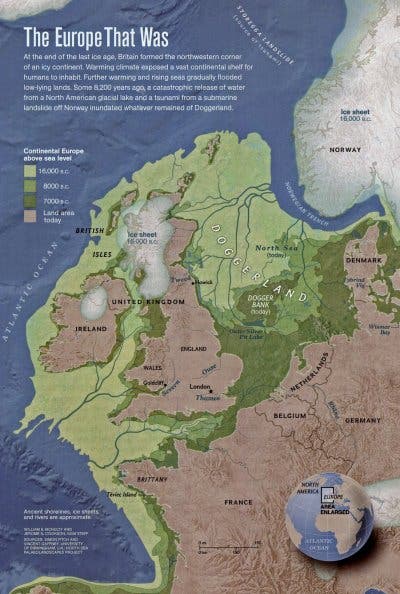The area beneath what is now the North Sea, between the UK and the rest of Europe, was once a thriving area called Doggerland. Doggerland was inhabited by Mesolithic populations up until it slowly became submerged some 8,000 years ago. Now, researchers believe they are close to finding a submerged settlement of this lost area.

The area of interest is located around Brown Bank: an elongated, 30 kilometres long sand ridge, roughly halfway between the UK and the Netherlands. This area has been surveyed numerous times, though not necessarily for archaeology. An impressive trove of archaeological material was dredged up by fishing vessels, including flint tools, spear points, and even human bones, suggesting that this was indeed the place of a settlement — or at the very least, very close to it. Furthermore, thousands of sediment cores were also taken from the area, most recently for a planned offshore wind farm.
In 2018, researchers from the University of Bradford launched an expedition to find the lost prehistoric settlement of the Brown Bank. Working with Ghent University and Flanders Marine Institute, they started carrying geophysical surveys. For the most part, the team is carrying seismic surveys: using waterborne airgun onboard a research ship, they emit shockwaves which travel through the subsurface and is reflected back to the ship, where the data is recorded and the structure of the subsurface is analyzed. This approach is routinely done by oil and gas companies who are looking to map reservoirs. It won’t reveal anything archaeological, though — at least not directly.
Instead, what the team is doing is mapping the subsurface relief, the geography of the now-submerged Doggerland, currently covered by marine sediment. Here’s an example of what the data looks like — this is essentially a “slice” of the subsurface, and multiple of these profiles can be pieced together to create a 3D view of Doggerland.
Lots of data continues to flow in for #BrownBank2019 and the sun is shining ☀, looks like it's going to be a great day on the @HowBigIsBelgica 👍.@LostFrontiersBD
@RBINSmuseum@jmeesvliz@ugent@UniofBradford pic.twitter.com/9NvC1Qhuaw— Brown Bank 2018 (@BrownBank2018) May 14, 2019
Until sea levels rose at the end of the last Ice Age (8-10,000 years ago), the area we now call Doggerland connected Great Britain to Scandinavia and the continent. The team has identified plains, hills, marshlands and river valleys across thousands of kilometers — but despite this, evidence of human activity has remained elusive.
Dr. David Garcia Moreno from Ghent University said:
“Confirmation of the location of a prehistoric lake near the Brown Bank and the characterization of the fluvial system associated with it would be a breakthrough. Such a discovery would have vast implications in our understanding of the palaeogeographic evolution of northwestern Europe since the last Ice Age”.
The next stage of the project is to retrieve sediment cores from the most interesting areas. Thousands of such cores have already been taken from the area, not only for archaeological reasons but also for things like developing wind farms. These cores will be analyzed to better understand Doggerland’s environment, but also to look for signs of human activity. Researchers are dredging up of soil from the most promising areas.
The preliminary findings indicate perfect conditions for a settlement: wetlands, where there is plenty of water, as well as a diverse food source (including birds, fish, and shellfish).
Additionally, a trove of archaeological material (including bone, stone, and human remains) have been found around Brown Bank — a concentration which suggests that a prehistoric settlement is close by. Fishing ships operating in the area have also occasionally discovered archaeological remains — researchers are getting closer and closer, but they haven’t yet found a submerged settlement.
During the latest expedition, the team tried to dredge up samples from Brown Bank but came across a petrified forest which was too sturdy to dislodge. The team now hope to return with a bigger dredge, capable of harvesting the petrified wood.
All that’s missing is the big hit — a settlement. Researchers are confident that will also come soon enough. Dr. David Garcia Moreno from Ghent University concludes:
“Confirmation of the location of a prehistoric lake near the Brown Bank and the characterization of the fluvial system associated with it would be a breakthrough. Such a discovery would have vast implications in our understanding of the palaeogeographic evolution of northwestern Europe since the last Ice Age”.



